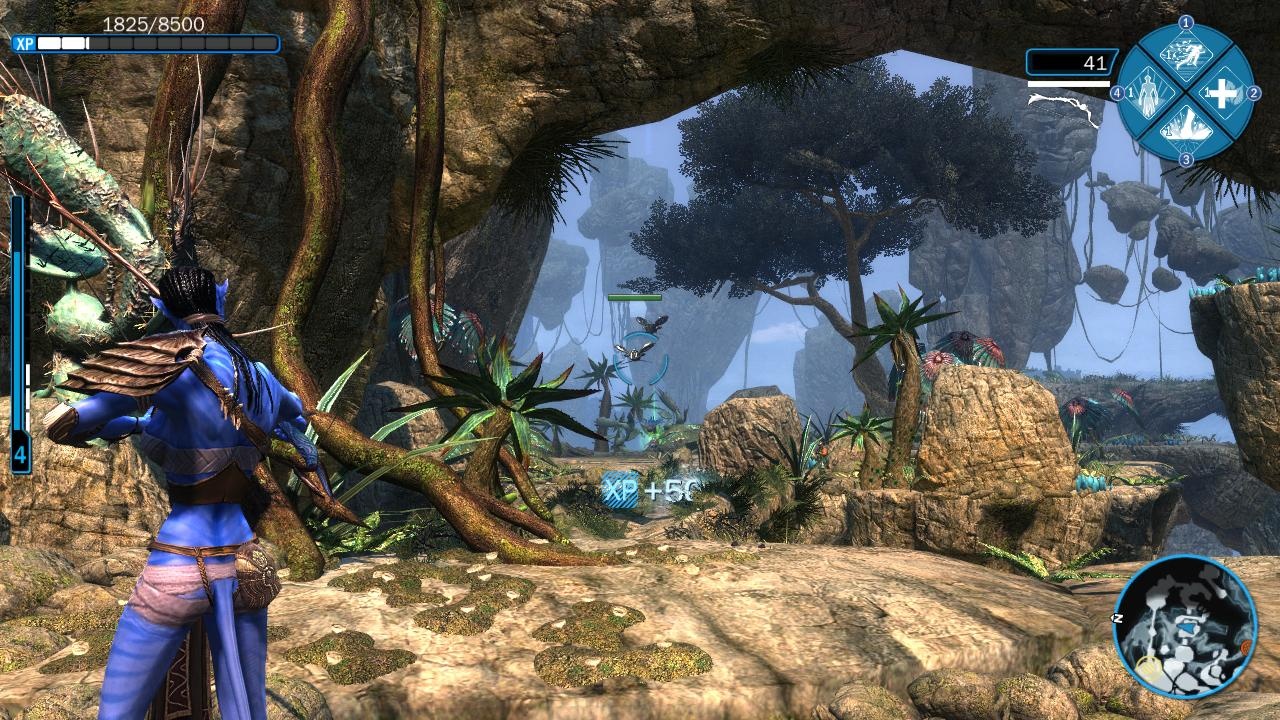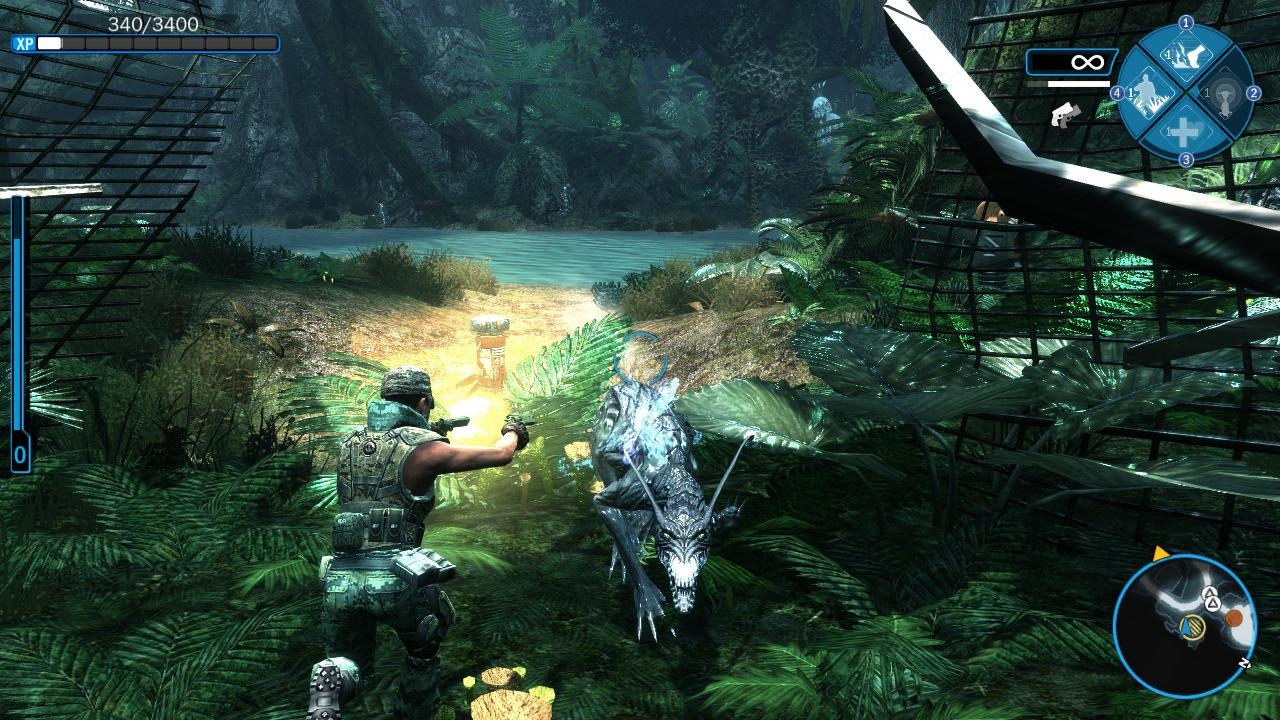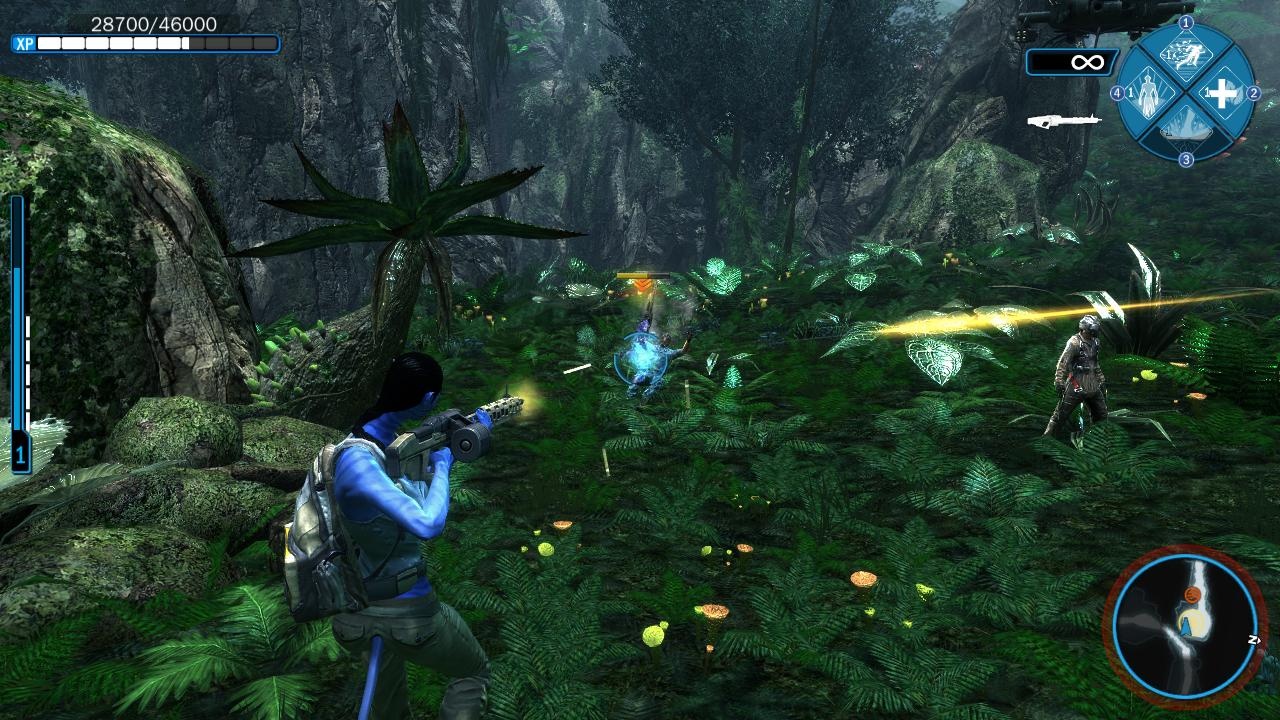Bigger doesn't mean better. Developer Ubisoft Montreal disregarded this mantra when creating James Cameron's Avatar, delivering a mediocre game loaded with unnecessary padding, rather than a tight and enjoyable package that could have gotten players excited about the upcoming film of the same name. In fact, if you're eagerly anticipating the upcoming Avatar movie, it's probably best that you avoid this bland and overlong third-person shooter altogether, because there's nothing fantastical or compelling about its story or characters. That isn't to say that Avatar is all bad. A branching story featuring two disparate factions makes this a two-games-in-one experience, so if you like wringing the last drop out of your $50, the single-player campaign might keep you busy for 15 hours or so. Unfortunately, while a few of those hours are entertaining, Avatar's action is too bland and tedious to justify the game's length, and a variety of bugs and bizarre design elements put a further damper on the fun.

Avatar takes place on the planet Pandora, which the human-controlled Resources Development Administration (RDA) is stripping of its resources--much to the dismay of Pandora's indigenous population, the blue-skinned Na'vi. Meanwhile, the RDA has established a way of transferring a human's consciousness into an artificially created human/Na'vi hybrid called an avatar. You play as Ryder, an RDA operative who soon finds himself (or herself, if you choose a female persona) in over his head as he discovers the consequences of the RDA's destructive presence on Pandora. About an hour into the campaign, you'll be faced with a choice: side with the RDA, or live as an avatar and take your chances with the Na'vi. Yet no matter which path you meander down, you'll meet a series of unmemorable characters, played by unexceptional voice actors who deliver their poorly written lines without a trace of enthusiasm or urgency.
More disappointingly, the game assumes a familiarity with the nature of avatars. Cutscenes are abrupt, and moments that should carry weight, such as the first time you enter the body of your giant blue avatar, are presented without a shred of wonder. Your own character embraces that same matter-of-fact approach, reciting the dialogue in monotone, even as events unfold that would make most folks' jaws drop. With few exceptions, humans come across as resource-hungry simpletons, while the Na'vi are reduced to monosyllabic native stereotypes. And no matter which faction you align with, the flabby ending sequence will make you wonder why you bothered to see the story through. The blend of sci-fi and fantasy seems conceptually solid, but the ideas were given a treatment so cavalier that it's impossible to care about the fate of this world, of its people, and of your own character.
You won't find any more magic in Avatar's world than in its story, because though it too seems conceptually solid, it's similarly diminished by a general lack of energy. Pandora is at first sight a beautiful place, covered in lush foliage and teeming with beasts both savage and submissive. If you follow the RDA route, some of the monstrous plants will even spew poisonous fumes at you or knock you over with a powerful swipe of their leaves (really). The environments are attractive in the way most jungles are, and sights of flying beasts overhead and winsome waterfalls in the distance make Pandora's beauty simultaneously inviting and imposing. Yet over time, the environments lose their allure. Dark greens and darker greens melt into each other, and the visuals start to feel heavy, which will make you long for a change of scenery. A few of the areas you visit provide much-needed variety, but even so, the atmosphere grows wearisome and eventually wears out its welcome.

Each of Pandora's explorable regions is relatively large, and missions often involve traveling long distances to get to your next objective. Along the way, you'll run into a number of different types of enemies that seek to destroy you. If you side with the Na'vi, you have a few instruments of death to keep you well protected. Your default bow will likely be your go-to weapon. However, the snap-to targeting on the console versions has been ditched on the PC, so bows are not much fun to use because it can be tough to spot camouflaged RDA foes amid all the green. You can also sport a machine gun, though it's rather feeble, so you're better off replacing it with another choice, such as the enormous spiked club, which is good for mowing down a few viperwolves at once. In fact, melee combat leads to Avatar's most consistently enjoyable kills: it can be a lot of fun to cartwheel toward your target and slice him up with your dual blades. You equip four weapons at a time, but you can switch them out for other available options, and over time, your weapons level up and you gain access to better armor. Leveling up isn't a game-changing mechanic--your core abilities remain more or less the same--but there's still something rewarding about rising to the next tier of weaponry.
If you go the way of the RDA instead, you won't wield any melee weapons and will instead shoot your way to victory. You've got a pair of pistols to get you through if the better guns run out of ammo, but they're all but useless; luckily, your shotgun, flamethrower, and other weapons seem appropriately powerful, if not exactly satisfying to use. Enemies that melt into the background and inconsistent hit detection make it feel like you're spraying bullets around willy-nilly much of the time, and humanoid enemies are too stupid to make shooting them exciting. Your foes often will ignore comrades falling over dead right in front of them, engage harmless creatures and ignore you as you pick them off, and walk directly into walls and continue to walk in place. Not that AI characters are the only ones prone to technical weirdness. You might get stuck in a crevasse while flying a banshee, fall into an inescapable fissure, or dismount from a direhorse directly into the geometry of the plant right next to it and be unable to get out.
Of course, what fantasy game would be complete without special powers? You get a number of skills to play around with no matter which side you choose, though it's odd that these abilities are never given any context--you just have to accept that they exist. Nevertheless, they're good to have on hand, and like weapons, skills become more effective as you level up. Your healing ability will become the most useful, because though you regenerate health quickly when not in battle, you'll need to heal yourself when engaged with enemies. There is some overlap between the factions aside from health regeneration. Both sides can sprint for a short period of time, and both can activate camouflage to remain hidden for a short time. Faction-specific skills include the Na'vi's ability to summon a swarm of insects, and the RDA's airstrike. Avatar isn't a difficult game, so you won't often need to employ your special skills, but it's still fun to watch a barrage of missiles devastate a crowd of Na'vi or to summon a viperwolf to fight at your side.

In spite of these special skills, Avatar soon becomes tragically predictable: shoot a group of enemies, travel toward the next hotbed of activity, and shoot some more. The pace rarely varies, so while its goodly length should seem like an asset, Avatar instead feels like it drones on for far too long. There's never a sense that the action is ramping up, and the few boss fights sprinkled about are too tepid to make things more interesting. For example, you take on a huge beast in a large clearing, which is easy to avoid in spite of the poor collision detection that allows it to knock you over even if it misses you by a few feet. When it dies, the creature falls to the ground with little fanfare and dissipates seconds later. Talk about an anticlimax. The by-the-numbers missions don't help matters and serve only to artificially extend Avatar's length. Go here, collect these herbs, and report back. Go to these locations, shoot down some towers, and check back in. Go there, collect these different herbs, and bring them back. This tedium is particularly evident when playing on the Na'vi side, so it's hard not to feel like a big blue personal assistant.
Luckily, you can cut down on your travel time by using Avatar's vehicles and mounts, and in this case, the Na'vi get the better deal. You can ride a few different creatures, and there's a bit of a thrill in flying through the air on a colorful banshee. However, it takes time to get used to the unusual controls, which make ascending and descending unnecessarily complex. If you want to stick to good old Pandora firma, direhorses will be your standard choice. These horselike creatures get the job done, though weak animations and sound effects make riding one seem more like floating about in a hovercar with legs than riding atop a great beast of burden. But direhorses are preferable to the RDA options, in particular the buggies. When you get behind the wheel of a buggy, the camera swoops and sways with every bump and bounce. The effect is so nauseating, it's better to stay on foot and keep your lunch than to take a rover and lose it. Luckily there are a few other options, though not all of them fare better. Gunships, for example, are as awkward to pilot as banshees.
Avatar's most intriguing idea is its implementation of a turn-based strategy minigame called Conquest, which you can access from the game's fast-travel stations. As you play through the campaign, you earn funds that you can spend on units in Conquest mode. In Conquest mode, you capture territories, thereby earning boosts in the campaign, such as earning more experience points or increasing damage. This is a terrific idea, and it's fun to play around in Conquest for a short while, as simple as it is. However, Avatar is not a challenging game, so the enhancements you receive from capturing territories aren't noticeably helpful, and you could easily finish the game and reach maximum level without even knowing that Conquest exists.

Avatar's multiplayer modes aren't quite as useless as Conquest, letting up to 16 players compete in a variety of modes like Team Deathmatch, King of the Hill, and Capture the Flag. The multiplayer suite feel less like a throwaway than you might expect for a movie tie-in but the factions play so differently that weird imbalances become quickly apparent. A Na'vi player can crush an RDA player with a single swipe of his club, while an RDA player can jump in a mech suit and mow Na'vi down without much fuss. (Though oddly, the swarm of insects Na'vi players can unleash make short work of those big hunks of metal.) The factional differences make for some initially appealing variety, but the disparity is too great--and the basic mechanics too bland--to support long online sessions. The mechs don't feel heavy enough to make them fun to pilot, and the cavorting camera renders buggies as uncomfortable to drive in multiplayer sessions as they are in the campaign.
One of Avatar's main selling points is its use of 3D technology, so if you own a display with the right capabilities, you may get a kick out of seeing Avatar pop out of your screen. Yet even if you're one of the few lucky enough to see the game this way, no screen yet has the capability of making James Cameron's Avatar: The Game play any better than it does. It's not a bad game, and portions of it are competent, if not quite remarkable. But Avatar wears thin quickly, and the story is too fragile to compensate for the deficiencies.